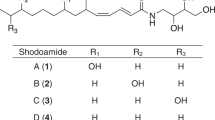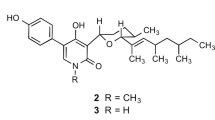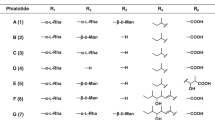Abstract
ACTIDIONE, an antibiotic produced by Streptomyces griseus1, inhibits the growth of fungi, including yeasts. The genetic basis of resistance to the drug has been fully worked out by Wilkie and Lee2 in the yeast Saccharomyces cerevisiae. The aim behind the production of analogues and derivatives is two-fold: first, to detect active groups in an attempt to define chemically the effect of actidione on sensitive cells of S. cerevisiae (believed to be inhibition of DNA synthesis3,4) and, secondly, to use them to investigate the mechanism of resistance via gene action in the cells of various resistant strains. Anhydroactidione, dehydroactidione and dihydroactidione were prepared, following the method of Kornfeld et al.5. These compounds have the following structural formulae:  As can be seen from Table 1, removal of the hydroxyl group does not impair the biological activity of the drug and all the strains tested show precisely the same degree of sensitivity or resistance to anhydroactidione as to the actidione itself. On the other hand, the activity of the dehydro- and dihydro-derivatives is reduced by exactly the same amount in all cases, although these compounds would be expected to show differences in chemical activity. Thus cells that are sensitive to actidione and anhydroactidione (that is, show no growth at concentrations of 0.5 p.p.m.) are resistant to 10 p.p.m. of the dehydro- and dihydro-derivatives, while the cells of all other strains tested show a 100-fold increase in resistance to dehydro- and dihydro-actidione. The fact that these two derivatives, unlike actidione and the anhydro-derivative, are insoluble in water (their effects are studied in medium containing 5 per cent alcohol in each case) suggests that their reduced activity may be due to a decrease in the amount getting into the cell rather than to the change in chemical properties. Of interest in this connexion is the finding that the rate of kill of sensitive cells in the presence of actidione is correlated with the availability of nutrient metabolites in the medium (Fig. 1) or, in other words, the uptake of the drug seems to parallel that of metabolites. Put another way, the effect of the actidione appears to be proportional to metabolic activity, although, of course, sensitive cells do not get to the stage of undergoing division.
As can be seen from Table 1, removal of the hydroxyl group does not impair the biological activity of the drug and all the strains tested show precisely the same degree of sensitivity or resistance to anhydroactidione as to the actidione itself. On the other hand, the activity of the dehydro- and dihydro-derivatives is reduced by exactly the same amount in all cases, although these compounds would be expected to show differences in chemical activity. Thus cells that are sensitive to actidione and anhydroactidione (that is, show no growth at concentrations of 0.5 p.p.m.) are resistant to 10 p.p.m. of the dehydro- and dihydro-derivatives, while the cells of all other strains tested show a 100-fold increase in resistance to dehydro- and dihydro-actidione. The fact that these two derivatives, unlike actidione and the anhydro-derivative, are insoluble in water (their effects are studied in medium containing 5 per cent alcohol in each case) suggests that their reduced activity may be due to a decrease in the amount getting into the cell rather than to the change in chemical properties. Of interest in this connexion is the finding that the rate of kill of sensitive cells in the presence of actidione is correlated with the availability of nutrient metabolites in the medium (Fig. 1) or, in other words, the uptake of the drug seems to parallel that of metabolites. Put another way, the effect of the actidione appears to be proportional to metabolic activity, although, of course, sensitive cells do not get to the stage of undergoing division.
This is a preview of subscription content, access via your institution
Access options
Subscribe to this journal
Receive 51 print issues and online access
$199.00 per year
only $3.90 per issue
Buy this article
- Purchase on Springer Link
- Instant access to full article PDF
Prices may be subject to local taxes which are calculated during checkout
Similar content being viewed by others
References
Whiffen, A. J., Bohonos, N., and Emerson, R. L., J. Bact., 52, 610 (1946).
Wilkie, D., and Lee, B. K., Genet. Res. (in the press).
Kerridge, D., J. Gen. Microbiol., 19, 497 (1958).
Bennett, L. L., Smithers, D., and Ward, C. T., Biochim. Biophys. Acta, 87, 60 (1964).
Kornfeld, E. C., Jones, R. G., and Parke, T. V., J. Amer. Chem. Soc., 71, 150 (1949).
Lerman, L. S., Proc. U.S. Nat. Acad. Sci. Wash., 49, 94 (1963).
Author information
Authors and Affiliations
Rights and permissions
About this article
Cite this article
LEE, B., WILKIE, D. Sensitivity and Resistance of Yeast Strains to Actidione and Actidione Derivatives. Nature 206, 90–92 (1965). https://doi.org/10.1038/206090b0
Issue Date:
DOI: https://doi.org/10.1038/206090b0
This article is cited by
-
Detoxication of cycloheximide by resistant strains ofSchizophyllum commune
Folia Microbiologica (1978)
-
Selektion Actidion-resistenter Mutanten bei Neurospora crassa sowie ihre genetische und biochemische Analyse
MGG Molecular & General Genetics (1970)
-
A cytoplasmic factor in the resistance of yeast cells to actidione and its response to uv-irradiation
Genetica (1965)
Comments
By submitting a comment you agree to abide by our Terms and Community Guidelines. If you find something abusive or that does not comply with our terms or guidelines please flag it as inappropriate.



